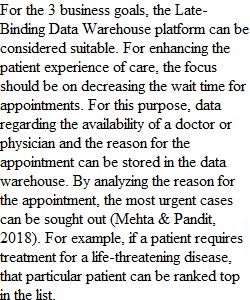


Q Access your case study Links to an external site.. The three business goals for the data warehouse in the case study are: • Improving the patient experience of care (including quality and satisfaction) • Improving the health of populations • Reducing the per person cost of healthcare The case study concentrates on the advantages and disadvantages of different architectures for data warehouses. In addition to architecture, the data analyst must also determine what data to capture in the data warehouse to achieve the business goals. For example, one way to improve the patient experience (the first business goal) could be to reduce waits times for appointments. In order to understand what causes wait times, data about the scheduled start time, actual start time, scheduled end time, actual end time, availability of the doctor, and reason for the appointment would have to be analyzed in the data warehouse. Other ways to improve the patient experience could include: getting the diagnosis right the first time, knowing the cost upfront, avoiding second appointments with specialists, providing supplemental information for patients to read at home, etc. Each of those improvements would require different types of data in the data warehouse. Your assignment is to specify at least one improvement for each of the three business goals above. For the improvement you identify, indicate what specific data would have to be stored in the data warehouse to analyze ways to achieve that improvement. Also specify how that data would be obtained. Your paper should be 1 – 3 pages in APA format. Include at least one paragraph for each of the three business goals above. Submit your MS Word document via the assignment link. Resources: • Textbook: Module 13 – Business Intelligence and Data Warehousing • Video: Module 13 – Introduction to Data Warehousing (5:27 min.) • PowerPoint: Module 13 Review charts Rubric Weekly Course Assignment Rubric Weekly Course Assignment Rubric Criteria Ratings Pts This criterion is linked to a Learning OutcomeCritical Thinking 20 pts Main points are concise, clear and well developed. Evidence and detail provide superior support for the assignment. 18 pts Main points are clear and well developed. Evidence and detail provide strong support for the assignment. 16 pts Main points are clear and developed. Evidence and detail adequately support the assignment. 14 pts Presents an incomplete analysis of the issues identified and demonstrates an inadequate understanding of the topic(s) and issue(s). 20 pts This criterion is linked to a Learning OutcomeAnalysis 20 pts Makes appropriate and powerful connections between the issues identified and the strategic concepts studied in the reading; Demonstrates complete command of the strategic concepts and analytical tools studied. Supports diagnosis and opinions with strong arguments and evidence; presents a balanced and critical view; interpretation is both reasonable and objective. 18 pts Makes appropriate connections between the issues identified and the strategic concepts studied in the reading; Demonstrates good command of the strategic concepts and analytical tools studied. Supports diagnosis and opinions with reasons and evidence; presents a fairly balanced view; interpretation is both reasonable and objective. 16 pts Makes appropriate but somewhat vague connections between the issues and concepts studied in the reading; Demonstrates limited command of the strategic concepts and analytical tools studied. Supports diagnosis and opinions with limited reasons and evidence; presents a somewhat one-sided argument. 14 pts Makes little or no connection between the issues identified and the strategic concepts studied in the reading. Supports diagnosis and opinions with few reasons and little evidence; argument is one-sided and not objective. 20 pts This criterion is linked to a Learning OutcomeKnowledge of Content 20 pts Exceeds requirements in demonstrating strong knowledge of content and depth. 18 pts Knowledge of content and depth are appropriately reflected in the assignment. 16 pts Supplements case study with limited research into the present situation of the company; provides limited documentation of sources consulted. 14 pts Some knowledge of content and depth are evident. 20 pts This criterion is linked to a Learning OutcomeAssignment Purpose 20 pts Presents detailed, realistic, and appropriate recommendations clearly supported by the information presented and concepts from the reading. 18 pts Work is accurately detailed. The weekly assignment requirements are adequately addressed. 16 pts Work reflects the assignment purpose. The weekly assignment requirements are somewhat addressed. 14 pts Work rarely reflects the assignment purpose. The weekly assignment requirements are rarely addressed. 20 pts This criterion is linked to a Learning OutcomeNo Description 20 pts Writing demonstrates a sophisticated clarity, conciseness, and correctness; includes thorough details and relevant data and information; extremely well-organized. Uses APA guidelines accurately and consistently to cite sources. 18 pts Writing is accomplished in terms of clarity and conciseness and contains only a few errors; includes sufficient details and relevant data and information; well-organized. Uses APA guidelines with minor violations to cite sources. 16 pts Knowledge of content and depth are satisfactory. 14 pts Writing is unfocused, rambling, or contains serious errors; lacks detail and relevant data and information; poorly organized. Uses APA guidelines with major violations to cite sources. 20 pts Total Points: 100
View Related Questions